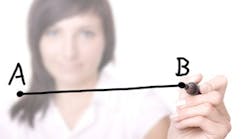"End users want higher speeds in their food, packaging and other machines, and so they're all getting faster, more complex — and need more control," says Brad Weedon, pneumatic actuator product manager at SMC Corp. of America. "That's why users want to know when components such as pneumatic cylinders have reached the end of their stroke, so they can time their devices better. Our two-color indicator is an end-of-stroke sensor that turns green when the cylinder is in the optimum hysteresis range, but now we also have timers for faster cylinders and diagnostics that can send signals to the control system when there's a problem."
Similarly, SMC's MPC Series pneumatically controlled position actuators are a hybrid of linear and pneumatic technology, which packaging applications typically use for automatically adjusting conveyor rails, lanes, ceilings, and heat sealing or glue guns. "These adjustments used to be done manually, but combining the cylinder, solenoid and linear transducer gives us an easier way to send signals and do positioning," Weedon says.
"Linear actuation has been going from pneumatic to electrical for 10–15 years, but its latest generation, such as our Card Motor, is providing the accuracy, savings on compressed air and power, and transition from small to large force ranges that users need," adds Daniel Rebennack, SMC's electrical actuator product manager.
End users always want more flexibility and faster throughput, but in the past five years they've pursued more integrated connectivity and easily programmable controls as a way to handle more varied patterns and shapes and produce more different types of parts on the same machine, reports Joe Profeta, product management director at Aerotech. "As a result, we're transforming linear and rotary motion controllers into devices that are closer to PLCs and IEC 61131-compliant machine controllers," he says. "For instance, our A3200's base does motion control, but it also has an optional MotionPAC module for PLC functions and another module to interface with all kinds of fieldbuses. Likewise, when building machines, some engineers like to use ladder logic and structured text, while others like to program in G code, and so our new Global Tag database and I/O mapping tool does all the plumbing, lets them work together, and saves integration time."
Hack Summer, applications technology manager at Moog Animatics, says, "Builders are tired of dealing with moving loads via pneumatics and hydraulics, and they're moving to direct-drive linear and servo motors. Machine builders used to ask how to get their drives and controls to work together. However, today they work as one, and so the questions are about what linear actuator to bolt on based on its durability, who can supply it fastest, and if they have complementary, pre-configured, plug-and-play products."
Of course, once you begin moving through three dimensions, navigating diagonals and curves is probably next because they're faster than up and over.
"Normally, a linear motor system consists of a linear magnetic track and one active carrier, and motion is constrained to back and forth in one plane," says Matt Lecheler, motion specialist at Beckhoff Automation. "However, our upcoming eXtended Transport System (XTS) combines linear motor technology on a continuous-motion track that consists of straight and curved track segments, allowing machine designers to configure topologies for many applications. The XTS track is like an inverse linear motor that's engineered for multiple carriers. The track contains the active coils and encoding, while each mover has a passive set of magnets with encoder flag and roller wheels. Mechanically driven continuous motion, such as from belts or chains, is outperformed by XTS because each mover's position is controlled individually and can be adjusted on the fly with precision."






